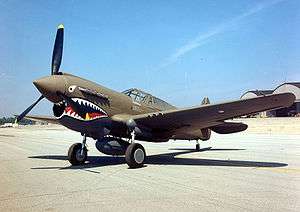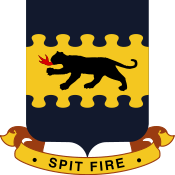Jerome Edwards
2nd Lieutenant Jerome Edwards (December 26, 1918 - May 7, 1943)[1] from Steubenville, Ohio, is a member of the famed group of World War II-era African-Americans known as the Tuskegee Airmen. He was a recipient of the Congressional Gold Medal in 2007 (Posthumously).[2] Edwards served in the 332nd Fighter Group During WWII and was killed in 1943 while taking off from his airbase in his P-40.[3]
2nd Lieutenant Jerome Edwards | |
|---|---|
 Jerome Edwards (1942) | |
| Birth name | Jerome Thompson Edwards |
| Born | December 26, 1918 Steubenville, Ohio |
| Died | May 7, 1943 (aged 24) Steubenville, Ohio |
| Buried | Union Cemetery (40.369186°N 80.633088°E) |
| Allegiance | |
| Service/ | United States Army Air Force |
| Years of service | 1942-1943 |
| Rank | 2nd Lieutenant |
| Unit |
|
| Awards |
|
| Relations | Brother John Ellis Edwards |
Military service
World War II


After graduating from West Virginia State College and completing WVSC's civilian pilot program in 1940, Edwards went to Tuskegee where he became a pilot. He was assigned to the 99th Fighter Squadron, 332nd Fighter Group. He was trained on P-40 and P-51 aircraft and assigned to Oscoda Army Air Field. He was killed in a training exercise when his P-40 suffered a catastrophic failure upon takeoff May 7, 1943. His death was the first for the 332nd Fighter Group.[1]
There is a mural (located along Washington Street in Steubenville, OH) dedicated to Jerome Edwards and his bother John Ellis Edwards. Both were Tuskegee airmen.[3] He and his brother also have their names engraved in the Tuskegee Airmen Memorial located in Sewickley Cemetery in Sewickley, Pennsylvania.[5]
Awards
- Congressional Gold Medal (2007)[2]
Education
- Steubenville High School[1]
- West Virginia State College[1]
Personal life
Edward and Willie Edwards were his parents.[6] He had a brother (John) and sister (Gwendolyn). His parents moved to Steubenville, Ohio.[7]
Jerome Edwards and his brother John Ellis Edwards both went to Steubenville High School and after graduation both attended Virginia State College. The college then became one of the first black colleges to enroll pilots in a Pilot Training Program. Both brothers were Tuskegee Airmen after completing training in Tuskegee.[1]
Further reading
- The Tuskegee Airmen: An Illustrated History, 1939-1949[8]
- "Born to Fly the Skies." Weirton Daily Times (Weirton, W.Va.) 23 February 2013. Web. 17 January 2014.
- "Tuskegee Airmen Pilot Listing." Tuskegee University, 2014, Web. 17 January 2014.
- Murphy, Justin D. and Matthew A. McNiece. Military aircraft, 1919–1945: An Illustrated History of their Impact. Santa Barbara, California: ABC-CLIO, 2009. ISBN 978-1-85109-498-1.
References
- "Profile of Tuskegee Airmen brothers Jerome and John "Ellis" Edwards". CAF Rise Above. CAF Rise Above. Retrieved August 10, 2020.
- Rangel, Charles B. (April 11, 2006). "Tuskegee Airmen Gold Medal Signed Into Law". Press Release. United States House of Representatives. Retrieved November 26, 2008.
- "Legacy of 2 Tuskegee Airmen From Steubenville Honored". The Intelligencer Wheeling News. May 9, 2020. Retrieved August 10, 2020.
- Murphy and McNiece 2009, p. 83
- "The Tuskegee Airmen Memorial". Sewickley Cemetery. webCemeteries.com. Retrieved August 10, 2020.
- "Tuskegee Airmen". findagrave.com. Find a Grave. Retrieved August 10, 2020.
- "John Ellis Edwards Air Force and family photograph albums ([1940s]-1973)". University of Michigan. U-M Library. Retrieved August 10, 2020.
- Caver, Joseph; Ennels, Jerome A.; Haulman, Daniel Lee (2011). The Tuskegee Airmen: An Illustrated History, 1939-1949. Montgomery: New South Books. p. 394. ISBN 978-1588382443. Retrieved February 6, 2020.
Notes
- The Curtiss P-40 Warhawk is an American single-engined, single-seat, all-metal fighter and ground-attack aircraft that first flew in 1938. The Warhawk was used by most Allied powers during World War II, and remained in frontline service until the end of the war. [4]
External links
- Tuskegee Airmen at Tuskegee University
- Tuskegee Airmen Archives at the University of California, Riverside Libraries.
- Tuskegee Airmen, Inc.
- Tuskegee Airmen National Historic Site (U.S. National Park Service)
- Tuskegee Airmen National Museum
- Fly (2009 play about the 332d Fighter Group)